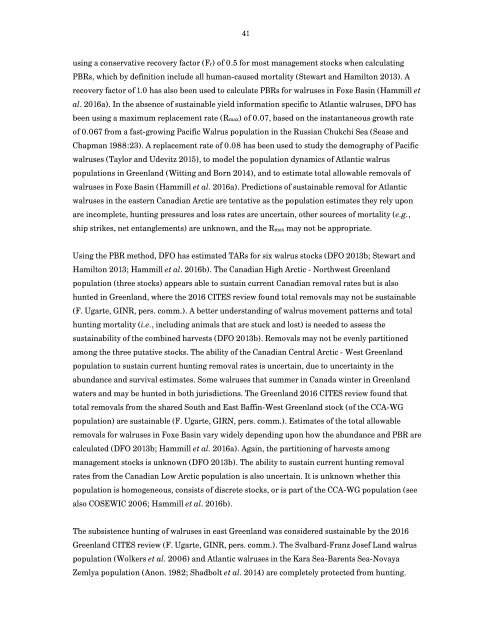The State of Circumpolar Walrus Populations
walrusreport
walrusreport
Create successful ePaper yourself
Turn your PDF publications into a flip-book with our unique Google optimized e-Paper software.
41<br />
using a conservative recovery factor (Fr) <strong>of</strong> 0.5 for most management stocks when calculating<br />
PBRs, which by definition include all human-caused mortality (Stewart and Hamilton 2013). A<br />
recovery factor <strong>of</strong> 1.0 has also been used to calculate PBRs for walruses in Foxe Basin (Hammill et<br />
al. 2016a). In the absence <strong>of</strong> sustainable yield information specific to Atlantic walruses, DFO has<br />
been using a maximum replacement rate (Rmax) <strong>of</strong> 0.07, based on the instantaneous growth rate<br />
<strong>of</strong> 0.067 from a fast-growing Pacific <strong>Walrus</strong> population in the Russian Chukchi Sea (Sease and<br />
Chapman 1988:23). A replacement rate <strong>of</strong> 0.08 has been used to study the demography <strong>of</strong> Pacific<br />
walruses (Taylor and Udevitz 2015), to model the population dynamics <strong>of</strong> Atlantic walrus<br />
populations in Greenland (Witting and Born 2014), and to estimate total allowable removals <strong>of</strong><br />
walruses in Foxe Basin (Hammill et al. 2016a). Predictions <strong>of</strong> sustainable removal for Atlantic<br />
walruses in the eastern Canadian Arctic are tentative as the population estimates they rely upon<br />
are incomplete, hunting pressures and loss rates are uncertain, other sources <strong>of</strong> mortality (e.g.,<br />
ship strikes, net entanglements) are unknown, and the Rmax may not be appropriate.<br />
Using the PBR method, DFO has estimated TARs for six walrus stocks (DFO 2013b; Stewart and<br />
Hamilton 2013; Hammill et al. 2016b). <strong>The</strong> Canadian High Arctic - Northwest Greenland<br />
population (three stocks) appears able to sustain current Canadian removal rates but is also<br />
hunted in Greenland, where the 2016 CITES review found total removals may not be sustainable<br />
(F. Ugarte, GINR, pers. comm.). A better understanding <strong>of</strong> walrus movement patterns and total<br />
hunting mortality (i.e., including animals that are stuck and lost) is needed to assess the<br />
sustainability <strong>of</strong> the combined harvests (DFO 2013b). Removals may not be evenly partitioned<br />
among the three putative stocks. <strong>The</strong> ability <strong>of</strong> the Canadian Central Arctic - West Greenland<br />
population to sustain current hunting removal rates is uncertain, due to uncertainty in the<br />
abundance and survival estimates. Some walruses that summer in Canada winter in Greenland<br />
waters and may be hunted in both jurisdictions. <strong>The</strong> Greenland 2016 CITES review found that<br />
total removals from the shared South and East Baffin-West Greenland stock (<strong>of</strong> the CCA-WG<br />
population) are sustainable (F. Ugarte, GIRN, pers. comm.). Estimates <strong>of</strong> the total allowable<br />
removals for walruses in Foxe Basin vary widely depending upon how the abundance and PBR are<br />
calculated (DFO 2013b; Hammill et al. 2016a). Again, the partitioning <strong>of</strong> harvests among<br />
management stocks is unknown (DFO 2013b). <strong>The</strong> ability to sustain current hunting removal<br />
rates from the Canadian Low Arctic population is also uncertain. It is unknown whether this<br />
population is homogeneous, consists <strong>of</strong> discrete stocks, or is part <strong>of</strong> the CCA-WG population (see<br />
also COSEWIC 2006; Hammill et al. 2016b).<br />
<strong>The</strong> subsistence hunting <strong>of</strong> walruses in east Greenland was considered sustainable by the 2016<br />
Greenland CITES review (F. Ugarte, GINR, pers. comm.). <strong>The</strong> Svalbard-Franz Josef Land walrus<br />
population (Wolkers et al. 2006) and Atlantic walruses in the Kara Sea-Barents Sea-Novaya<br />
Zemlya population (Anon. 1982; Shadbolt et al. 2014) are completely protected from hunting.


